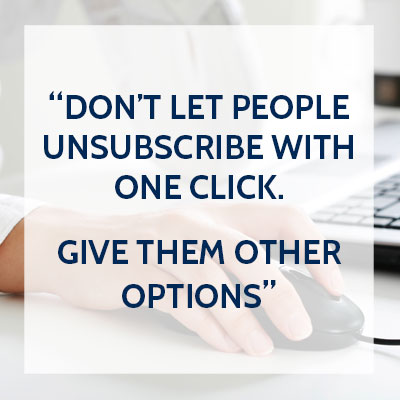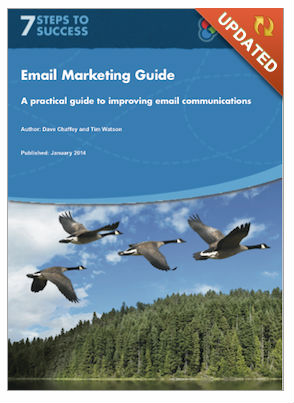 Is your email marketing neglected compared to your social media marketing?
Is your email marketing neglected compared to your social media marketing?
Do you struggle to get people to sign up – let alone open your messages?
Still not sure what content works best?
To learn how to create a powerful email campaign, I spoke to Tim Watson, author of Smart Insights’ Email Marketing Guide.
His valuable insights include:
- What your first email to subscribers should say
- How to segment your list (even if you’ve never done it before)
- The one simple trick that will help you work out how often to email people
- Why you shouldn’t make it too easy to unsubscribe
- How to measure whether your emails are working
And much more. Enjoy!
MIRIAM SHAVIV: People are paying lots of attention to social media marketing, but much less to email marketing although it’s widely used. Why do you think this is?
TIM WATSON: When social media started becoming big news 3-4 years ago, there were a lot of people saying ‘That’s probably the end of email’. It’s proven totally unfounded. Email is as strong as ever, in fact the vibe in the industry is that there’s a resurgence. Lot of people turned to this shiny thing called ‘Social’, but then realised it can’t replace the role of email – it’s just another channel. Everyone still needs an email address.
People are less likely to focus on email because it’s not seen as glamorous, exciting, sexy or as the ‘next big thing’. Marketers are also worried about being seen as spammers. Spam has done a lot of damage to professional email marketing, but it’s not spam – it’s permission-based, people have signed up or bought from your company, and people are happy to receive email from brands they trust.
MS: So do social media and email marketing work completely separately, or together?
TW: Together. The one brand that sends more emails than any other is actually Facebook. As Twitter has been commercialising, it has developed paid-for ads. To get the message across, they email people.
MS: Does email marketing work particularly well for a certain type of audience?
TW: The best-performing lists are permission-based – those you collect yourself directly through a lead-generation campaign on a website, competitions or recommend-a-friend. When people give their address to a specific brand, they are now happy to hear from them. If you try to buy an email list, particularly B2C, it won’t work well for you. Generally ISPs have such deliverability controls, you’ll get blocked.
Some marketers do add their LinkedIn contacts or business cards they’ve collected to their email lists. It’s about how you handle it. You need to ask people whether you can send them updates, news and useful industry information – ideally explain what you are going to do with their email address. I don’t put someone onto an email list without asking them first.
MS: In your guide, you stress that you must manage the expectations of those on the list. How do you do this?
TW: At the point where you’ve collected the email addresses, let people know what you’re going to do with them. Then clarify with a welcome email what kind of content they can expect and how often.
It’s a low-cost thing to do that will make them more accepting of your emails: They know they did say yes to this, and you can make clear how it’s relevant to them. It’s a psychological step.
MS: You also argue that you have to be very clear about the goals for your list before you start building it.
TW: Unless you know how you’re going to use your list, you can’t articulate how you’re going to communicate with people. You can’t tell them, ‘Give us your email, we’ll figure out how we’re going to use it later’.
Also, if you’re looking to collect profile data [when people sign up] – age, job title, 2-3 pieces of data – unless you have a clear idea of what your campaign is, you don’t know what to ask for.
A classic error it to create a sign-up form and the marketer comes up with 5 things they think would be nice to know. Six months later they realise it’s not useful for campaigning and they’ve lost a big opportunity. You can change your creative strategy relatively quickly, give your email a new look – it’s hard to go back two years later and ask people again how old they are.
MS: To make your email most effective, you need to send different emails to different groups. What’s the best way to segment your audience?
TW: By behaviour. For some retailers gender and age is important, but beyond that, it’s about behaviour – what people have looked at on your website, what they’ve bought from you, how long since they’ve last engaged with you, what pages are they viewing on your emails.
If you sell five different solutions in your B2B company, from small businesses to multinationals, what people are looking at is the biggest clue for segmentation and targeting. It’s something you can apply after they’ve signed up.
If you’re not doing segmentation at all, start small. Work out which factors best identify people who are very different to other people in your list – significant differences. For example if you provide IT solutions to companies with different needs, don’t look for endless small iterations. Look for the biggest defining differences.
MS: What’s the biggest mistake people make with email marketing?
TW: Relevance. It goes back to segmentation. If you send the wrong info, it won’t do much for you.
MS: How should you structure your email to be most effective?
TW: Focus on what the email is trying to get people to do – have you structured the email around the objectives of your campaign? There are broadly two types of email:
1. Converter – There’s a single focus to your email. You want someone to renew a service contact, download a book or attend an event. You need your emails to be totally focused on the objective – the mistake is to put other stuff in that’s too distracting.
2. If it’s more of a browsing email, it’s fine to have lots of different things going on in an email. Make it scannable, quick to consume, make sure the benefit is clear, and that it talks about ‘you’.
Marketers get very excited if they release a new website and decide to send out a new email, which says, ‘We’re really excited about the hard work we’ve been doing on our new website, come and take a look.’ It’s completely the wrong language, all about what the marketers want, not the consumer. The same email could say, ‘We’ve changed a lot, come and save money, find 10 new types of info that will help you.’ Rather than taking the customer’s point of view, talk from the brand point of view.
The classic test is to count the number of ‘Me’s’, ‘You’s’ and ‘I’s’. Unless you have twice as many you’s as me’s, you’re doing it wrong.
MS: How easy should you make it for people to opt out?
 TW: Opt-out is a legal requirement, and rightly so. It makes email an honest channel – just try opting out of telemarketing or ads on the web.
TW: Opt-out is a legal requirement, and rightly so. It makes email an honest channel – just try opting out of telemarketing or ads on the web.
But you shouldn’t make it too easy with a one-click unsubscribe button. Always have a link back to a landing page where subscribers can confirm that they wish to unsubscribe and you can offer them a different option, for example to change their preferences or take a break. They can snooze for 12 weeks.
But don’t hide your unsubscribe button. People try stuff and decide it’s not for them – why are we so fearful? It’s nice to have a low unsubscribe rate, but don’t worry about losing people to the extent of being paranoid. There will always be unsubscribers. Just make it transparent.
MS: How can you measure if your email marketing is working?
TW: The best measure is revenue, if you can track that. If you can’t, the number of customers you’re engaging in a month or quarter. This could be how many are opening your email, downloading your white paper or visiting your website, for example.
But click-through-rate is not a business metric, it’s more of a diagnostic metric. We need to measure customers, not campaigns: Recency of engagement, frequency of engagement and scoring of customers are far better measures.
MS: How often should you be emailing?
TW: It’s really hard to figure out. The only way is to split-test it. Be clear about your KPIs – trying to get the maximum open rate / revenue / recency. Then run a split test – email half the list twice as frequently, see if you get more success as defined by your business metric. There’s no good way to tell a brand how often to email without this – there’s no theoretical answer.
MS: How has mobile affected email marketing?
TW: Mobile is another reason why email has seen a resurgence in the last 2-3 years as people realised that social was not driving all their revenue. People picked up smartphones, making email a 24/7 channel. When they wake up, they look at their mobile device. Email is checked more than social according to surveys.
People do worry about whether email looks good on a mobile device, and the concern has driven even simpler designs and responsive designs. Emails that will appear on desktops in their full glory with menu bars and extra options, appear in a stripped down version on the mobile.
But when mobiles first appeared, screens were quite small. They’re now big enough to be embarrassing in your pocket – they’re huge! That’s alleviated some of the issues because with screens 30% bigger, there are more pixels to play with. Being suitable to mobile won’t go away, but the level of problems will drop. If you’re not mobile compliant, it won’t hurt you as much as some agencies lead you to believe.
Tim Watson has over 9 years of experience specialising in email marketing. Through his consultancy work at Zettasphere he helps brands develop email strategies that get more out of the email marketing channel. When not consulting he speaks and blogs on all things email marketing related and is the Chair for the DMA Email Marketing Best Practice group.
His eBook, Email Marketing Guide: Learn How to Get More From Your Email Marketing, co-authored with Dave Chaffey, is published on Smart Insights.






